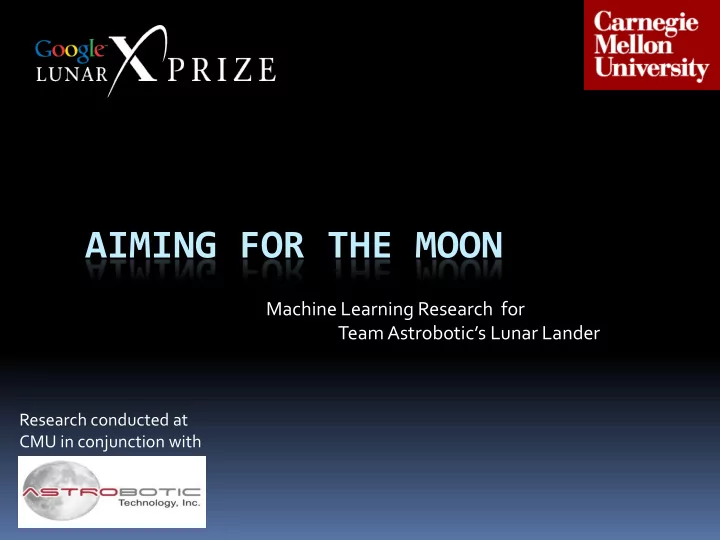

AIMING FOR THE MOON Machine Learning Research for Team Astrobotic’s Lunar Lander Research conducted at CMU in conjunction with
Research Behind Lunar Lander Challenges of a Lunar Lander ML Research for the Lander - FTW Lander Perception / Visual Registering Upcoming Work for Dec. 2012 Launch
Motivation of Lunar Exploits Lunar Resources Unfiltered solar energy Clean fusion (helium3) Methane, ammonia, minerals Lunar docking bay No gravity Available fuel Watchtower Base for infrared telescopes (icy craters)
Research Behind Lunar Lander Challenges of a Lunar Lander ML Research for the Lander - FTW Lander Perception / Visual Registering Upcoming Work for Dec. 2012 Launch
It has been done 1969 – Apollo 11 manned mission 1970 – Luna 17 with Луноход (Lunokhod 1) remote controlled robot View from Camera 2 Images from Wikipedia and www.mentallandscape.com
So where is the novelty? Pinpoint Landing - 500 m Less than a hundredth of a degree (lat/long) High autonomy Little or no human support in landing Preset trajectory Fault detection Error recovery Proof of concept – reliable commercial lander
Stages of Landing Orbit insertion Determine Lander orientation
Stages of Landing Orbit insertion Determine Lander orientation De-orbit and breaking Determine orbital parameters
Stages of Landing Orbit insertion Determine Lander orientation De-orbit and breaking Determine orbital parameters Descent – 18km to 500m Keep track of Lander coordinates
Stages of Landing Orbit insertion Determine Lander orientation De-orbit and breaking Determine orbital parameters Descent – 18km to 500m Keep track of Lander coordinates Touch down 500m to 150m: compute slopes, detect craters Less than 150m to surface: detect small obstacles
Challenges – Perception Detect whether Lander is off course Detect whether sensors function properly NO CAMERA - for a while In case of off-course landing, pick landing spot
Research Behind Lunar Lander ML Research for the Lander - FTW Lander Perception / Visual Registering Upcoming Work for Dec. 2012 Launch
Research - Vision Landscape identification Feature tracking Mega-structures Craters Obstacle detection
Research – Evidence Fusion Density Elevation Map (DEM) construction Sparse LIDAR readings Images of surface Combine sensor readings to obtain position Voting scheme to determine faulty components
Research – Knowledge and AI Decision unit in the Lander Inference to determine Position Lander State Planning Save fuel resources Pick landing spot to facilitate rover movement
Research Behind Lunar Lander Lander Perception / Visual Registering Upcoming Work for Dec. 2012 Launch
Lander Sensor Array Stage Requirement Sensor Orbit insertion Attitude IMU Sun position Sun tracker/Star tracker Pre-defined Orbital Parameters Deorbit Attitude Camera/IMU Descent stage Attitude Camera/IMU (18kms to 500mts) Planning Touch down Attitude Camera/IMU (500mts to ground) Altitude Pointed RADAR Slope of Ground LIDAR Velocity Doppler Surface characteristics LIDAR/Camera
Visual Registering Step 1: Crater Detection Crater Detection on LRO Image Crater Detection on Image captured by camera on the Black Magic platform
Visual Registering Step 2: Comparing Landscape to Stored Data Test Set True False True False Positives Positives Negatives Negatives Apollo 11 4/5 3/20 17/20 1/5 Apollo 14 3/5 4/20 16/20 2/5 Apollo 16 5/5 3/20 17/20 0/5 Apollo 17 4/5 4/20 16/20 1/5
Digital Elevation Map Sparse LIDAR data (Lunar Reconnaissance Orbiter
Digital Elevation Map Image (LCROSS Impact)
Markov Random Field X – image Z – sparse elevation measurements Y – estimated elevation map L – points where elevation readings exist N(i) – neighborhood of point i on the grid w ij – correlation between pixels in image Z X LIDAR (1% of available data) Image of cabeus crater
MRF with Shading Coefficient X – image Z – sparse elevation measurements Overlap of Y – estimated elevation map image and L – points where elevation readings exist LIDAR N(i) – neighborhood of point i on the grid w ij – correlation between pixels in image Pixel correlation Shading coefficient p =5% quantile of image data – the shaded pixels
Experiment - Terrain Model
Experiment – Model + LIDAR
MRF Results Elevation map after interpolation • mean error 175.20 m • 16.09% of average elevation Elevation map after 200 iterations of Coordinate Descent • mean error 143.75 m • 13.2% of average elevation
Scanning for a landing site Image-based landing site selection Elevation-based landing site selection
Research Behind Lunar Lander Upcoming Work for Dec. 2012 Launch
Work for December 2012 Launch Feature Tracking AI unit Decisions Inference Planning Integrated Testing Framework
Recommend
More recommend